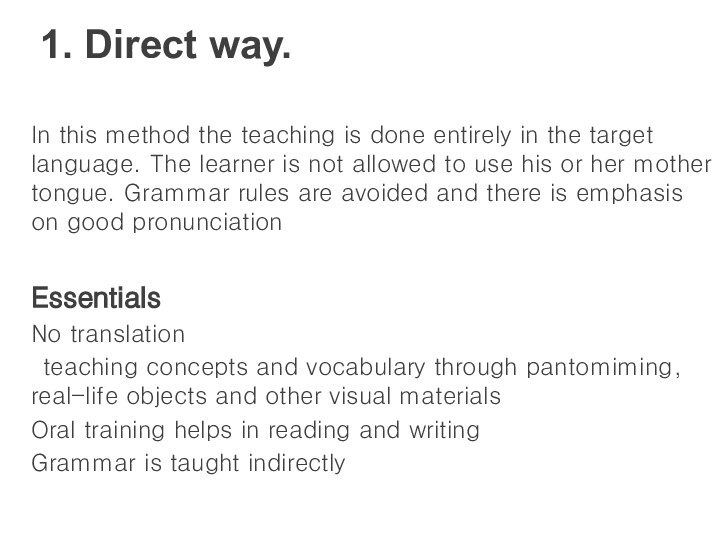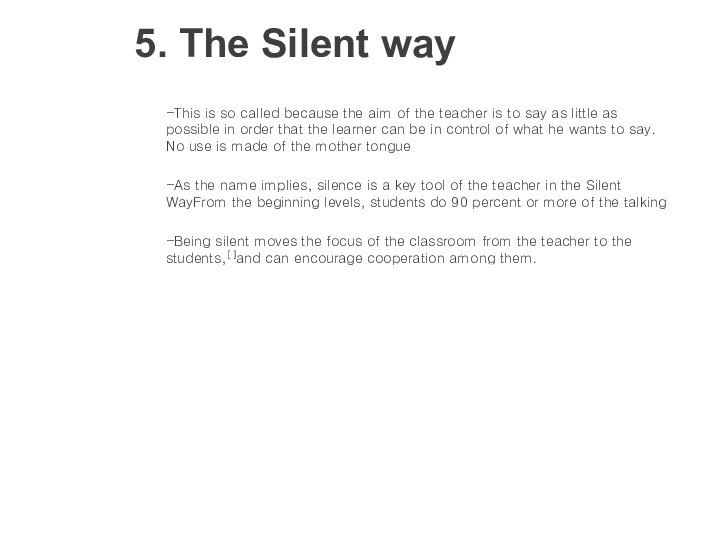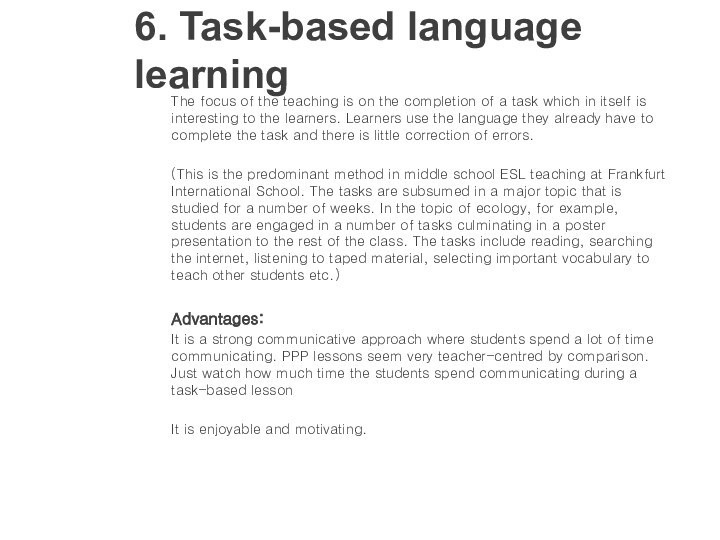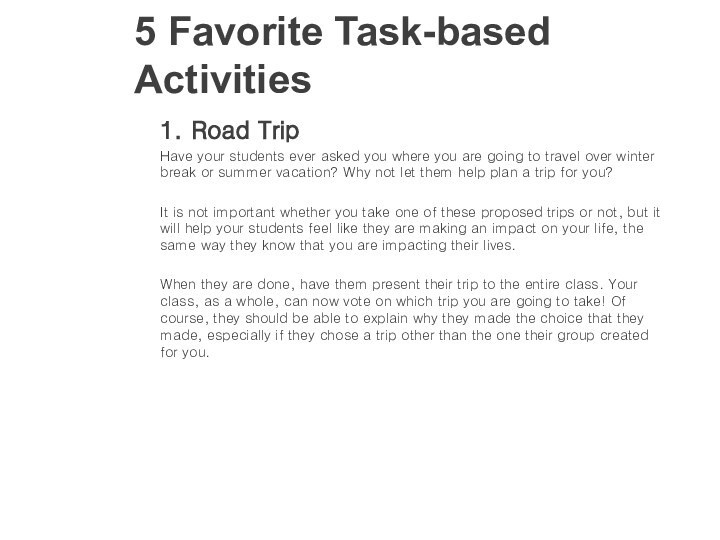- Главная
- Разное
- Бизнес и предпринимательство
- Образование
- Развлечения
- Государство
- Спорт
- Графика
- Культурология
- Еда и кулинария
- Лингвистика
- Религиоведение
- Черчение
- Физкультура
- ИЗО
- Психология
- Социология
- Английский язык
- Астрономия
- Алгебра
- Биология
- География
- Геометрия
- Детские презентации
- Информатика
- История
- Литература
- Маркетинг
- Математика
- Медицина
- Менеджмент
- Музыка
- МХК
- Немецкий язык
- ОБЖ
- Обществознание
- Окружающий мир
- Педагогика
- Русский язык
- Технология
- Физика
- Философия
- Химия
- Шаблоны, картинки для презентаций
- Экология
- Экономика
- Юриспруденция
Что такое findslide.org?
FindSlide.org - это сайт презентаций, докладов, шаблонов в формате PowerPoint.
Обратная связь
Email: Нажмите что бы посмотреть
Презентация на тему Choosing methods for different age groups
Содержание
- 2. Plan:IntroductionDirect way methodGrammar- translation methodAudio-lingual methodTotal Physical ResponseThe Silent WayTask- Based language learning
- 3. IntroductionThere is a large number of methods
- 4. 1. Direct way.In this method
- 5. Techniques using direct way Question/answer exercise –
- 6. 2. Grammar-translation methodLearning is largely by
- 7. 3. Audio-lingual method The theory behind this
- 8. 4. Total Physical Response (TPR) TPR works
- 9. Why should I use TPR methodin the
- 10. 5. The Silent way-This is so called
- 11. How to use Silent way method? Silence can
- 12. 6. Task-based language learning The focus of
- 13. 5 Favorite Task-based Activities 1. Road TripHave
- 14. 2. Department of TourismEach small group should
- 15. Скачать презентацию
- 16. Похожие презентации
Plan:IntroductionDirect way methodGrammar- translation methodAudio-lingual methodTotal Physical ResponseThe Silent WayTask- Based language learning















Слайд 2
Plan:
Introduction
Direct way method
Grammar- translation method
Audio-lingual method
Total Physical Response
The
Silent Way
Слайд 3
Introduction
There is a large number of methods used
in teaching different age group. According to academic research,
linguists have demonstrated that there is not one single best method for everyone in all contexts, and that no one teaching method is inherently superior to the others.Also, it is not always possible – or appropriate – to apply the same methodology to all learners, who have different ages, objectives, environments and learning needs.
Слайд 4
1. Direct way.
In this method the
teaching is done entirely in the target language. The
learner is not allowed to use his or her mother tongue. Grammar rules are avoided and there is emphasis on good pronunciationEssentials
No translation
teaching concepts and vocabulary through pantomiming, real-life objects and other visual materials
Oral training helps in reading and writing
Grammar is taught indirectly
Слайд 5
Techniques using direct way
Question/answer exercise – the teacher
asks questions of any type and the student answers.
Student
self-correction – when a student makes a mistake the teacher offers him/her a second chance by giving a choice.Conversation practice – the students are given an opportunity to ask their own questions to the other students or to the teacher..
Слайд 6
2. Grammar-translation method
Learning is largely by translation
to and from the target language. Grammar rules are
to be memorized and long lists of vocabulary learned by heart. There is little or no emphasis placed on developing oral ability.This method focuses on reading and writing and has developed techniques which facilitate more or less the learning of reading and writing only. As a result, speaking and listening are overlooked
Слайд 7
3. Audio-lingual method
The theory behind this method is
that learning a language means acquiring habits. There is
much practice of dialogues of every situations. New language is first heard and extensively drilled before being seen in its written form.Drills and pattern practice are typical (Richards, J.C. et-al. 1986):
Repetition: the student repeats an utterance as soon as he hears it.
Inflection: one word in a sentence appears in another form when repeated.
Replacement: one word is replaced by another.
Restatement: the student rephrases an utterance.
Examples
Inflection: Teacher: I ate the sandwich. Student: I ate the sandwiches. Replacement: Teacher: He bought the car for half-price. Student: He bought it for half-price. Restatement: Teacher: Tell me not to smoke so often. Student: Don't smoke so often!
Слайд 8
4. Total Physical Response (TPR)
TPR works by having
the learner respond to simple commands such as "Stand
up", "Close your book", "Go to the window and open it." The method stresses the importance of aural comprehensionTPR can be used to teach and practise many things.
Vocabulary connected with actions (smile, chop, headache, wriggle)
Tenses past/present/future and continuous aspects (Every morning I clean my teeth, I make my bed, I eat breakfast)
Classroom language
(Open your books)
Imperatives/Instructions
(Stand up, close your eyes)
Storytelling
Слайд 9
Why should I use TPR methodin the classroom?
It
is a lot of fun, students enjoy it and
it can be a real stirrer in the class. It lifts the pace and the mood.It is very memorable. It really helps students to remember phrases or words.
It is good for kinaesthetic learners who need to be active in the class.
It can be used in large or small classes. It doesn't really matter how many students you have as long as you are prepared to take the lead, the students will follow.
You can extend this by playing Simon Says. This time when you give a command, students should only do it if you say "Simon says..." at the start. I might say, "Simon says, 'slice some bread'" or "Simon says, 'chop an onion'" and the students must do the action. However if I say, "Whisk an egg" the students shouldn't do this. If anyone does the action that Simon doesn't say then they are out and have to watch for the mistakes of the other students.
A game I like to play is to organize the students into a circle around me, I say the word and the last person to do the action is out. This person then stands behind me and watches for the student who does the action last. Eventually there is only one student, she is the winner.
Слайд 10
5. The Silent way
-This is so called because
the aim of the teacher is to say as
little as possible in order that the learner can be in control of what he wants to say. No use is made of the mother tongue-As the name implies, silence is a key tool of the teacher in the Silent WayFrom the beginning levels, students do 90 percent or more of the talking
-Being silent moves the focus of the classroom from the teacher to the students,[]and can encourage cooperation among them.
Слайд 11
How to use Silent way method?
Silence can be
used to help students correct their own errors. Teachers
can remain silent when a student makes a mistake to give them time to self-correct;[-they can also help students with their pronunciation by mouthing words without vocalizing, and by using certain hand gestures.
-When teachers do speak, they tend to say things only once so that students learn to focus their attention on them.
-A Silent Way classroom also makes extensive use of peer correction. Students are encouraged to help their classmates when they have trouble with any particular feature of the language
Example The teacher shows the learners a small red Cuisenaire rod and a bigger blue one and says ‘The blue one is bigger than the red one'. The learners repeat this. The teacher then substitutes the rods to produce other models, and finally encourages the learners to produce their own comparisons.
Слайд 12
6. Task-based language learning
The focus of the teaching
is on the completion of a task which in
itself is interesting to the learners. Learners use the language they already have to complete the task and there is little correction of errors.(This is the predominant method in middle school ESL teaching at Frankfurt International School. The tasks are subsumed in a major topic that is studied for a number of weeks. In the topic of ecology, for example, students are engaged in a number of tasks culminating in a poster presentation to the rest of the class. The tasks include reading, searching the internet, listening to taped material, selecting important vocabulary to teach other students etc.)
Advantages:
It is a strong communicative approach where students spend a lot of time communicating. PPP lessons seem very teacher-centred by comparison. Just watch how much time the students spend communicating during a task-based lesson
It is enjoyable and motivating.
Слайд 13
5 Favorite Task-based Activities
1. Road Trip
Have your students
ever asked you where you are going to travel
over winter break or summer vacation? Why not let them help plan a trip for you?It is not important whether you take one of these proposed trips or not, but it will help your students feel like they are making an impact on your life, the same way they know that you are impacting their lives.
When they are done, have them present their trip to the entire class. Your class, as a whole, can now vote on which trip you are going to take! Of course, they should be able to explain why they made the choice that they made, especially if they chose a trip other than the one their group created for you.
Слайд 14
2. Department of Tourism
Each small group should decide
where they would like to travel, if that has
not already been determined, and what they would use in a poster campaign to advertise that locale based on what they know about the place.3.Designing a brochure for a company
4. Making survey and presenting results
5. Interview about working conditions.





























